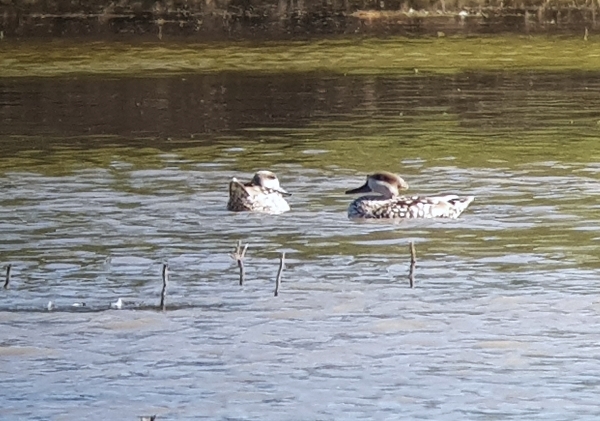
BIRDING COTO DONANA NATIONAL PARK
COREDOR DE VERDE - DEHESA ABAJO - NORTHERN MARSHES - JOSE VELVERDE CENTRE
WEATHER: very hot today, the temperature gauge in the bus registered 40C. It was more like 35C for most of the afternoon.
We left the hotel in the dark at 7am with our breakfast in a bag and we spent the first 40 minutes negotiating the roads, lanes and tracks to arrive in the Coredor de Verde. It was light and the air was full of bird song when we disembarked from the bus. Our breakfast was consumed fairly quickly on the spot and then birding began in earnest.
We were hoping for a sighting of the Black-winged Kite, the locale has always been a good site for them, but not today. Many other species were seen and heard but the only birds of prey seen were Black Kites and a Common Kestrel. We heard Common Cuckoo, Cetti’s Warbler, Common Nightingales and we saw Sardinian Warbler, Bee-eaters, Hoopoe, Zitting Cisticola, Greenfinch, Serin, Iberian Magpie, Woodchat Shrike and the ever-present Corn Bunting.
From a bridge nearby we inadvertently flushed six or seven Night Herons and Lorna, who was lagging behind us, found a Hawfinch!! We also found Common Waxbills, Cetti’s Warbler, Blackcap (heard). More searching for the Kite proved fruitless. We drove along the ‘coredor’ stopping to look and listen. Yellow Wagtails, Spanish Sparrow, Barn and Red-rumped Swallows went onto the list but not the Kite.
Our best birding of the day was at the huge reservoir at Dehesa Abajo. The whole area is going through a serious drought, the Donana marshes are completely dry and devoid of birds. The lack of water elsewhere meant that the water at Dehesa Abajo was in great demand. It was jammed packed full of birds, I have never seen such a big concentration in the twenty years I have visited Donana.

almost dry - the reservoir at Dehesa Abajo - there is a Sqacco Heron in this picture (LHS of the reedy channel)
We viewed from the eastern corner and scanned some reeds fairly close to us and a hedgerow of bushes. There we found two exotic species: Yellow-crowned Bishop and Black-headed Weaver, both very colourful species of African origin. We then found a Great Reed Warbler and quite unexpectedly, a Squacco Heron, how good was that?

our one and only Squacco Heron of the trip
The whole area of water held countless birds here are just a few: Greater Flamingo, Spoonbill, Glossy Ibis, Little and Cattle Egrets, Night Herons, vast numbers of Red-crested Pochards, Mallards, Gadwall and fewer of Shoveler.

a helicopter put up most of the birds, Greater Flamingos shown
Waders form great swarms, Black-winged Stilts, Avocets, Common Ringed Plover, Curlew Sandpipers and Dunlin. We also smaller numbers of Ruff, Kentish Plover, Redshank, Greenshank, Spotted Redshank, Black-tailed Godwits, Little Stint, Collared Pratincole and Little Ringed Plover. Purple Swamphens fed out in the open, they had no cover near the water, we saw 22 of them in one place!

a flotilla of 7 Marbled Ducks

Glossy Ibis, Purple Swamphen, Marbled Ducks, Black-winged Stilt and Greater Flamingos
The star bird of the show was the MARBLED DUCK, our most wanted target species, we saw a couple of dozen of those in small groups. The males, with their back of the head tufts were chasing the girls around. We walked along the southern shore and spent a lot time watching the birds on this half-empty reservoir. A few butterflies we also recorded: several Swallowtails, Small Skippers and Small Whites.

you can see the Tuft on this male Marbled Duck
For lunch we drove further along the road to a venta, where we bought a roll and a drink, we then set off for the Northern Marshes, a vast area of, now, dry baron land. Not a drop water could be seen in most of the marsh and a few pools existing near the pumping station called Casa Bombas.

Purple Swamphen feeding on reed stems
We saw our first Great Egret in a crowded pool where Little Egrets, Grey & Purple Herons, Glossy Ibis and Spoonbills all competed for little food.
Along the tracks to the Valverde Centre we noted many Corn Buntings, Yellow Wagtails, Crested Larks, Kestrels (both Common and Lesser) and a few Zitting Cisticola. We saw no other larks until we reached the Valverde Centre. On a fenced paddock system we found a Calandra Lark, a few Bee-eaters, Jackdaws and pair of Ravens.

Great Reed Warbler seen at the Valverde centre.
The pools around the Valverde Centre still had plenty of water and held quite a few species, we saw more Marbled Ducks and had much better views of Great Reed Warbler. Common Coot flock did hold their Red-knobbed cousin but we enjoyed watching the other birds too.
We left the centre around 4pm and took the long-route back, the very bumpy track. It was worth it as we found our first Whinchat, a beautifully marked male. Our second Northern Wheatear of the day was also seen and we found a Short-toed Eagle on a pylon and a very pale Buzzard not far away.

one more shot of the birds at Dehesa Abajo
It was a long and dry drive back the heat outside was too much for most of us, so we never stopped for any further walks. At 5pm we arrived back at the hotel, it was early but we gad packing to do as well as our relaxation and recovery time.
Our last dinner was taken once again out on the terrace, it was a lovely temperature and we had a good laugh and could not decide a 'bird of the trip' as everyone had a different choice.
